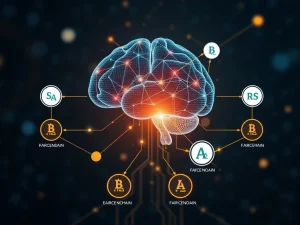Revolutionary AI: The Secret to Cheaper Compute Beyond GPUs

In the world of artificial intelligence, the focus has overwhelmingly been on powerful Graphics Processing Units (GPUs). Crypto enthusiasts know about the compute race, but often miss a crucial point: the obsession with GPUs for every AI task might be blinding us to a more accessible, cheaper, and smarter solution. This article dives into why we need to look beyond the GPU and embrace the potential of idle Central Processing Units (CPUs) and decentralized compute networks.
The Dominance of the GPU in AI
GPUs have earned their place in the spotlight, particularly for training massive AI models like large language models. Their architecture, designed for parallel processing, makes them incredibly efficient at handling the vast mathematical computations required for tasks such as image recognition or training deep neural networks. Companies like OpenAI, Google, and Meta invest heavily in building extensive GPU clusters, reinforcing the idea that GPUs are the only hardware that matters for AI.
However, this focus, while understandable for certain workloads, creates a significant blind spot. It leads to a perception that AI is solely about high-speed, parallel processing, ignoring the diverse range of tasks that make up a complete AI system.
Unlocking the Potential of the CPU for AI Tasks
While GPUs are specialized for parallel number crunching, Central Processing Units (CPUs) are the versatile workhorses of computing. They excel at flexible, logic-based operations, handling tasks sequentially or managing multiple tasks efficiently. The critical insight often missed is that many AI tasks don’t require the brute force parallelism of a GPU.
Consider the actual workflow of an AI application. It’s not just training or high-speed inference. It involves:
- Running smaller, optimized models.
- Interpreting and processing data.
- Managing complex logic chains and decision-making.
- Fetching and processing information (like documents).
- Orchestrating interactions between different AI components.
These tasks, requiring flexibility and logical processing, are perfectly suited for CPUs. Autonomous AI agents, for example, might call upon a GPU-powered language model, but the planning, decision-making, and execution logic all run effectively on a CPU. Even AI inference, using a trained model, can be handled by CPUs, especially for smaller models or applications where ultra-low latency isn’t the primary requirement.
Millions of machines worldwide have powerful CPUs sitting idle for significant periods. This represents an enormous, untapped resource capable of powering a wide range of AI tasks affordably and efficiently, if only we leverage it effectively.
Decentralized Compute Networks: The Smarter Solution
This is where decentralized compute networks, often known as DePINs (Decentralized Physical Infrastructure Networks), offer a revolutionary approach. Instead of relying solely on expensive, centralized GPU clusters, DePINs allow individuals and organizations to contribute their unused computing power – including those idle CPUs – to a global, distributed network. Others can then access this pooled resource on demand.
This model functions like a peer-to-peer marketplace for compute resources, distributing AI workloads across available machines and verifying execution securely, often using blockchain technology.
The benefits of this decentralized approach are clear:
-
Cost Efficiency: Accessing compute power from a decentralized network of existing CPUs is often significantly cheaper than renting scarce GPUs from centralized providers.
-
Natural Scaling: The network grows and scales organically as more participants contribute their idle resources.
-
Edge Computing: Tasks can be executed on machines geographically closer to the data source, reducing latency and enhancing data privacy.
-
Resilience: A distributed network is inherently more resilient to single points of failure compared to a centralized data center.
By intelligently routing AI tasks to the appropriate processor type – a GPU when absolutely necessary, but a CPU whenever possible – decentralized networks unlock massive potential for scaling AI infrastructure efficiently and affordably.
The Bottom Line: A Mindset Shift is Needed
It’s time to recognize that CPUs are not obsolete in the AI era. They are powerful, versatile, and widely available. While GPUs remain essential for specific high-end training tasks, CPUs are perfectly capable of handling a vast array of AI workloads that make up the bulk of real-world AI applications.
Instead of focusing solely on the perceived GPU shortage and the need for more expensive data centers, we should ask: Are we making the most of the computing power we already possess? Decentralized compute platforms are emerging to connect this untapped CPU potential to the growing demand for AI compute.
The real constraint on scaling AI might not be the availability of GPUs, but rather a limitation in our thinking. By shifting our mindset and leveraging the power of decentralized networks and the ubiquitous CPU, we can build a more scalable, affordable, and resilient AI future.
Opinion by: Naman Kabra, co-founder and CEO of NodeOps Network. This article is for general information purposes and is not intended to be and should not be taken as legal or investment advice. The views, thoughts, and opinions expressed here are the author’s alone and do not necessarily reflect or represent the views and opinions of Crypto News Insights.










